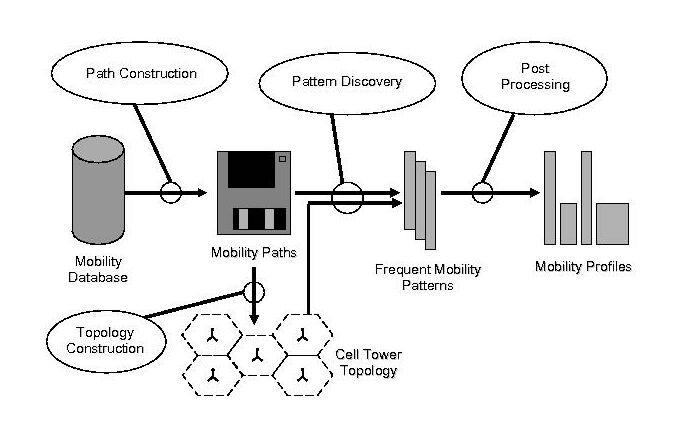 |
 |
 |
Navigation
Home
Projects
Publications
Members
Mobility Profiler: A
Framework For Discovering Mobile User Profiles
In this
project, we focus on the problem of discovering
mobility patterns and mobility profiles for mobile users from
the cellphone-based location logs. We define the mobility path concept
used for representing users travel path from one location to another
location. We construct the mobility paths of cell phone users from cell
tower connection data. We also propose a formal model for mobile user
profiles that integrates both frequent mobility patterns and contextual
time data for the user. We also present a complete framework, Mobility
Profiler, for discovering mobile user profiles starting from cell based
raw location data.

Figure 1: Mobility Profiler Framework
The General
architectire of
Mobility Profiler Framework is given in the figure above. In this
framework, we start with path construction which is an essential task
for grouping related cell tower connection transactions together. The
main goal of this process is constructing an ordered set of cell tower
ids correspond to user’s travel from one location to another.
After this task, topology construction process is executed. In this
process, cell tower neighborhood topology is extracted from mobile user
paths obtained in the first step. The topology information is used for
eliminating majority of candidate path sequences to expedite pattern
discovery phase. This step also provides visualization of cell tower
neighborhood information. Pattern discovery is the next step in our
framework; it is the major step which discovers core knowledge from
path data. There are two main dimensions of pattern discovery step
which are discovering global and personal mobility patterns. In global
pattern discovery, we analyze the common mobility patters shared among
all users. In personal one, we discover frequent mobility pattern for
each user separately. Both of these pattern discovery tasks are
executed efficiently by using topology information and string matching
support criteria. In post processing task, we generate cell phone user
profiles from personal mobility patterns by adding time contextual
data. In this way, we obtain a powerful representation of mobile user
profiles containing both time and location data. Possible Applications
of Our Framework are given below:
Project Members
Publications
- Mobile User Profiling (pre)
- Air Pollution Estimation (pre)
- Cell Tower Localization and Oscillation Elimination over Cell Span Data
- Using Mobility Behaviour for Opportunistic Routing Algorithms
- Social Network Analysis
Project Members
- Murat Demirbas, Principal Investigator, Asistant Prof. at SUNY at Buffalo
- Murat Ali Bayir, Co-Investigator, PhD Student at SUNY at Buffalo
Reseach Collaborators
- Nathan Eagle, Reseach Scientist, MIT
- Carole Rudra, Asistant Prof. at SUNY at Buffalo
- Atri Rudra, Asistant Prof. at SUNY at Buffalo
Publications
- Murat Ali Bayir, Murat Demirbas, Nathan Eagle, Mobility Profiler: A Framework for Discovering Mobile User Profiles, 2008 (Under Submission)
- Murat Demirbas, Carole Rudra, Atri Rudra, Murat Ali Bayir: IMAP: An Indirect Measurement of Air Pollution via Cell Phone, 2008 (Under Submission)
News
- Doctoral Student Murat Ali Bayir graduated, Congratulations Murat! May 2010.
- Crowd-Sourced Sensing and Collaboration Project got Google Research Award! Click here for details, March 2010.
- Asst. Prof. Dr. Demirbas got NSF Project Grant! Click here for details, September 2009.
- Doctoral Student Xuming Lu graduated, Congratulations Xuming! May 2009.
- Asst. Prof. Dr. Demirbas got Office of Naval Research Grant! Click here for details, April 2009.
- Two papers accepted to WOWMOM 2009 from Ubicomp Lab!, Click here for details, December 2008.
- Asst. Prof. Dr. Demirbas awarded NSF Career Award! Click here for details, January 2008.
© Copyright by UbiComp Lab., Dept. of Computer Science and Engineering, SUNY Buffalo.
All rights reserved.